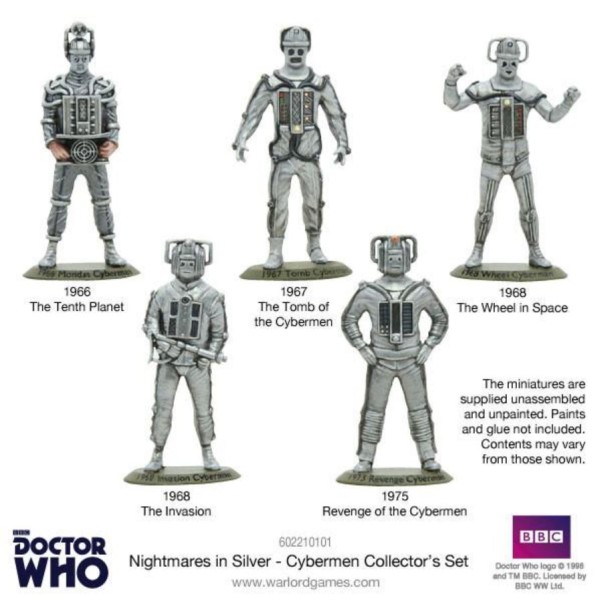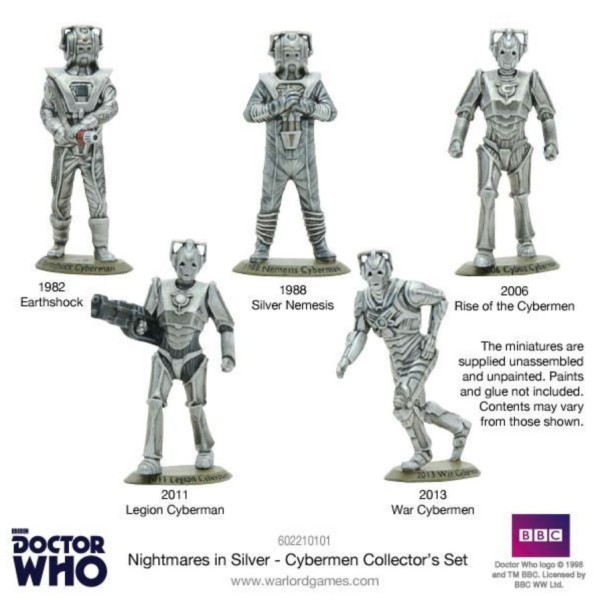The Dr Who Miniatures Game - Nightmares in Silver: Cybermen Collector's Set
- Brand: Warlord Games
- Product Code: 602210101
- Availability: Out Of Stock
-
- Ex Tax:
Description
The Cybermen, eternally popular (and very persistent!) villains, are second only to the Daleks in people’s minds when they think of classic Doctor Who monsters. Our latest release, to mark 50 years since their first on screen appearance, is a 10 figure pack featuring the key designs from over the decades.
History
Originating from Earth’s twin planet Mondas, the Cybermen were originally just like us in appearance, wholly organic humanoids who began to experiment in ways of self-preservation when they realised their planet’s resources were dying and their lifespans were shortening. Mondasian scientists, with machinery years ahead of Earth technology, began to implant artificial parts into bodies, until these parts started to replace vital organs. With cybernetic parts added to their brains, they started to lose their humanoid emotions and became cold, calculating and logic led cyborgs. In trying to save their race, they had become monsters.
The Cybermen, small in number, set out to conquer other organic beings, turning whole races into Cybermen, and constantly tried to upgrade themselves to stronger, deadlier versions.
Unlike the subtle changes to the Daleks over the history of the programme, the Cybermen have undergone several major re-designs over the years, but the retention of the silver colour scheme, round eyeholes and the iconic handlebars on the helmet is present on every design.
1966 Mondas Cyberman
The first figure in the set is an original Mondasian Cyberman from The Tenth Planet (1966). These Cybermen look like they have come straight from surgery, with bandages wrapped round their faces and their human hands still visible. This original design often proves controversial amongst some fans, who think the costumes have been tacked together from anything the costume designers could find at the time. These Cybermen reveal that Mondas has been knocked out of solar orbit into deep space and their plan is to drain the Earth of its energy in order to allow Mondas to return to the solar system. Ignoring the First Doctor’s warnings that Mondas is absorbing too much energy from Earth, it is eventually destroyed entirely, and those invading Cybermen are also all destroyed. At the conclusion of the story, the exhausted Doctor regenerates for the first time in front of his shocked companions, Ben and Polly.
1967 Moonbase/Tomb Cyberman
For their fairly quick return the following year in The Moonbase (1967), their look was overhauled to a more familiar design we are used to seeing today. Gone were the bulky chest units and head lamps, but the silver suits and boots remained, as did the large, circular, black eye sockets. Whilst still recognisable as the original Cybermen, they were now much more mobile and looked more robot than humanoid with no human parts visible. We do not learn how these Cybermen survived the destruction of Mondas, but they waste no time in targeting Earth for destruction using a weather control device called the Gravitron, housed on the moon. Naturally the Second Doctor (Patrick Troughton) uses this device against them and they are propelled into space. This new design, bar a change of footwear and a few subtle changes, was again featured in The Tomb of The Cybermen later the same year, where the metal men are discovered by explorers on the planet Telos, hibernating in underground tomb.
1968 Wheel In Space Cyberman
The Wheel In Space (1968) designs retained much of the previous look, however the now iconic ‘frozen teardrop’ shapes in the corner of their eyes were introduced. The Cybermen’s plan this time is to take over a marooned Earth space station in order to gather all their troops together and then invade Earth. They are destroyed by the Doctor using an x-ray laser. This story also marks the first appearance of Wendy Padbury, playing new companion Zoe Herriot, who would travel with the Second Doctor until his final adventure the following year.
1968 Planet 14 Cyberman
The next figure portrays a Cyberman from the 1969 story The Invasion, the fourth and final time the Second Doctor encounters their race. Again, the costumes had been modified from their previous appearance a year earlier, this time adding ‘ear muff’ type shapes to the sides of their helmets and one-piece silver wet suits to their bodies. In this story, the Doctor discovers the Cybermen have been hiding in late 20th century Earth, working with partially cyber-enhanced human Tobias Vaughn to bring their invasion fleet to destroy Earth. With the help of the newly formed UNIT, led by Brigadier Lethbridge Stewart, their plans are once again thwarted.
1975 Vogan War Cyberman
Bar a cameo appearance in Carnival of Monsters (1973), the Cybermen do not feature in the 3rd Doctor era at all. When we next encounter them in the 1975 story Revenge of the Cybermen, starring Fourth Doctor, Tom Baker, they have been once again re-designed, but this is mainly restricted to altered handlebars on the helmet. The handful of Cybermen in this adventure are depicted as survivors of the so-called ‘Cyber-Wars’ against Earth, in which the humans were victorious. We learn for the first time about their weakness to gold, and their determination to blow up earth’s rich gold supply on the asteroid Voga. Their bomb is used against them, and at the conclusion of the story their spaceship is destroyed with the remaining Cybermen on board.
1982 Earthshock Cyberman
Revenge of the Cybermen would be the only Cyberman story in the Fourth Doctor era, and another seven years passed before they featured in their own adventure again, in the Fifth Doctor story Earthshock. This would mark a major redesign for the monsters to bring them into the 1980s, the era of impressive-looking Star Wars Stormtroopers. The designers opted to use converted flight suits for their bodies which were painted silver, modified chest units that went over their shoulders, and the helmets added a transparent mouth section, so you could see the actor’s own mouths moving underneath. Whether this was intentional or not, it adds to the concept that there is a humanoid within the suit, and not purely a robot.
In this story, set in 2526, the Cybermen seek to destroy our planet with a large bomb while alien dignitaries visit Earth to discuss the ongoing Cyber-Wars. After the Doctor foils their latest plan, naturally, they decide to crash their freighter into the planet to much the same effect. The Doctor's companion, Adric, is trapped on board and attempts to escape from the freighter, but inadvertently causes it to hurtle back in time. The freighter crashes into prehistoric era Earth, killing him. This marked the first time a companion had perished on screen since Sara Kingdom aged to death in The Dalek’s Master Plan in 1965.
1988 Silver Nemesis Cyberman
The basic Earthshock design would be retained until their final classic series appearance in Silver Nemesis (1988) where a chrome like paint finish was added to the helmet and chest unit and spray painted cricket gloves used on their hands! This three-part adventure was marketed as the 25th Anniversary Special, appropriately using the ‘silver’ Cybermen for the silver anniversary.
The story featured the seventh Doctor and Ace visiting England in 1988, where they encounter three rival faction groups: the Cybermen, Lady Peinforte, and a Neo-Nazi group, who are all attempting to take control of a statue made of living metal, originally created on Gallifrey. This statue, created by President Rassilon, was designed to be the ultimate defence for the Time Lord planet. The Cybermen fleet are eventually wiped out by the power of the statue.
2006 Cybus Industries Cyberman
After an on-screen absence of 18 years, barring the occasional charity special, the Cybermen would make their long-awaited return in the 2006 story Rise of the Cybermen, and all that was on fans’ minds was what their latest upgrade would look like! How could you make the Cybermen both frightening and imposing for the 21st century? The answer was to cover them head to toe in body armour, to feature them en masse as relentless, marching, unstoppable killers.
This two-part adventure re-introduced the Cybermen as non-extraterrestrial beings from a parallel universe on an alternate Earth, created by Cybus Industries headed by the sinister John Lumic, closely associated with the government. Lumic’s scheme was to convert the population of London into Cybermen, literally upgrading humanity by placing human brains into metal exoskeletons to create an army of powerful, unstoppable machines. The original Cybermen from previous stories were entire humans placed in cybernetic suits - the difference with these new Cybermen was that only the brain was transferred.
2011 12th Cyber Legion Cyberman
The Matt Smith years saw the return of the Cybermen from Mondas, or at least a mixture of Mondas and Cybus technology, as their appearance was near identical to their previous design bar the removal of the Cybus logo from their chests. In the story A Good Man Goes To War, a new army of Cybermen were seen monitoring Demon’s Run from their ship. This slightly modified Cyberman design was later seen in Closing Time and 2013’s Nightmare In Silver.
2013 Upgraded Cyber War Cyberman
Nightmare In silver, the 2013 story written by Neil Gaiman, was unique as it featured two different designs within the narrative. We see empty battle damaged decaying 2011 versions housed at Hedgewick’s World of Wonders theme park, which are harmless deactivated museum pieces. Tiny Cybermite creatures cause the Cybermen to reactivate and upgrade themselves to a new, deadlier version that have remained onscreen to this day. Neil Gaiman imagined this new design as the result of a deep space meeting of Mondas and Cybus Cybermen who’s amalgamation resulted in an upgraded, stronger and superior model.
Models supplied unassembled and unpainted.




